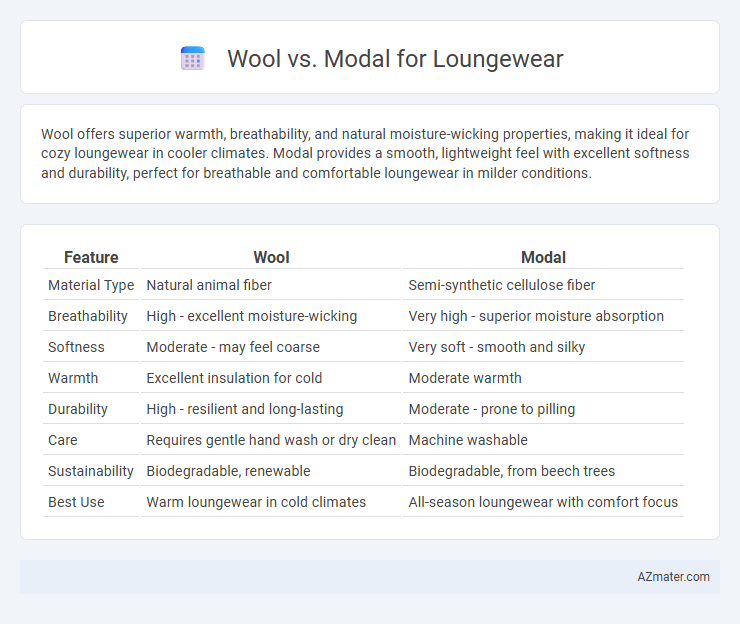Wool offers superior warmth, breathability, and natural moisture-wicking properties, making it ideal for cozy loungewear in cooler climates. Modal provides a smooth, lightweight feel with excellent softness and durability, perfect for breathable and comfortable loungewear in milder conditions.
Table of Comparison
| Feature | Wool | Modal |
|---|---|---|
| Material Type | Natural animal fiber | Semi-synthetic cellulose fiber |
| Breathability | High - excellent moisture-wicking | Very high - superior moisture absorption |
| Softness | Moderate - may feel coarse | Very soft - smooth and silky |
| Warmth | Excellent insulation for cold | Moderate warmth |
| Durability | High - resilient and long-lasting | Moderate - prone to pilling |
| Care | Requires gentle hand wash or dry clean | Machine washable |
| Sustainability | Biodegradable, renewable | Biodegradable, from beech trees |
| Best Use | Warm loungewear in cold climates | All-season loungewear with comfort focus |
Understanding Wool and Modal: Key Differences
Wool, derived from sheep fleece, offers excellent insulation, moisture-wicking properties, and natural breathability, making it ideal for temperature regulation in loungewear. Modal, a type of rayon made from beech tree pulp, is prized for its silky softness, high durability, and superior moisture absorption, providing a lightweight and smooth fabric feel. The key differences lie in wool's natural thermal and odor-resistant benefits versus modal's enhanced softness and color retention, impacting comfort and maintenance preferences in loungewear choices.
Comfort and Softness: Wool vs Modal
Modal fabric offers exceptional softness and a silky texture, making it highly comfortable for loungewear that directly contacts the skin. Wool provides natural warmth and breathability but can feel slightly coarse or itchy without proper treatment or blending with softer fibers. Modal excels in moisture-wicking and smoothness, while wool's insulating properties make it suitable for cooler environments despite its potential roughness.
Breathability and Temperature Regulation
Wool offers superior breathability and natural moisture-wicking properties, making it ideal for maintaining optimal body temperature in loungewear. Modal, derived from beech tree fibers, provides softness and moderate breathability but lacks wool's advanced temperature regulation capabilities. Wool's ability to insulate while allowing airflow ensures comfortable warmth without overheating, whereas modal excels in lightweight comfort but may retain more heat during prolonged wear.
Moisture-Wicking Abilities Compared
Wool excels in moisture-wicking due to its natural lanolin content, which repels water and pulls sweat away from the skin, keeping the wearer dry and comfortable. Modal, a semi-synthetic fiber made from beech tree pulp, offers good moisture absorption but tends to retain more moisture compared to wool, leading to a damp feel during extended wear. For loungewear, wool's superior breathability and quick-drying properties make it more effective in managing perspiration and maintaining dryness.
Durability and Longevity of Fabrics
Wool loungewear offers exceptional durability due to its natural resilience and ability to maintain shape over time, making it a long-lasting choice for everyday wear. Modal, a semi-synthetic fabric derived from beech trees, provides softness and breathability but tends to wear out faster with frequent washing, reducing its overall longevity. Choosing wool ensures sustained performance and extended fabric life, while modal prioritizes comfort but may require more careful handling to preserve durability.
Hypoallergenic Properties and Skin Sensitivity
Wool, especially merino, naturally offers hypoallergenic properties by repelling dust mites and resisting bacteria, making it ideal for sensitive skin prone to allergies. Modal fabric is also hypoallergenic, featuring a smooth, breathable texture that reduces irritation and moisture buildup, beneficial for individuals with delicate or reactive skin. Both materials provide excellent comfort, but modal's silky softness may be preferable for those with extreme skin sensitivity or eczema.
Care Instructions and Maintenance
Wool loungewear requires delicate care, including hand washing or using a wool-specific detergent on a gentle cycle with cold water to prevent shrinking and maintain softness. Modal fabric, known for its smooth texture, can be machine washed in cold or warm water, but avoiding high heat during drying preserves its durability and prevents pilling. Both fabrics benefit from air drying and avoiding bleach to extend the life and comfort of loungewear garments.
Sustainability and Eco-Friendliness
Wool is a natural, biodegradable fiber that offers excellent breathability and durability, making it a sustainable choice for loungewear due to its renewable sourcing from sheep. Modal, derived from beech tree cellulose, is considered eco-friendlier than conventional synthetics because it uses less water and energy in production, though it is not fully biodegradable. Choosing wool or modal loungewear reduces environmental impact compared to synthetic fabrics by promoting renewable materials and lower chemical use during manufacturing.
Cost and Value for Money
Wool loungewear tends to have a higher upfront cost due to the natural fiber's durability, moisture-wicking, and temperature-regulating properties, offering long-term value through longevity and comfort. Modal loungewear is usually more affordable initially, praised for its softness and breathability, but may wear out faster, reducing its overall value for money. Choosing between wool and modal depends on balancing budget with the desired lifespan and comfort features of your loungewear.
Wool vs Modal: Best Choice for Loungewear
Wool offers superior insulation and natural moisture-wicking properties, making it ideal for warmth and breathability in loungewear. Modal provides a silky softness and excellent drape, enhancing comfort and flexibility for casual wear at home. Choosing between wool and modal depends on whether you prioritize thermal regulation or lightweight softness in loungewear fabric.

Infographic: Wool vs Modal for Loungewear
 azmater.com
azmater.com